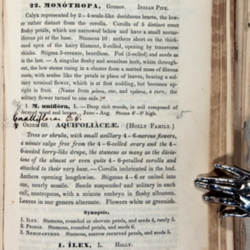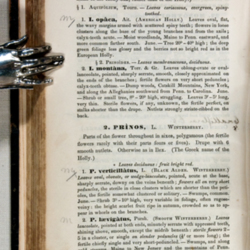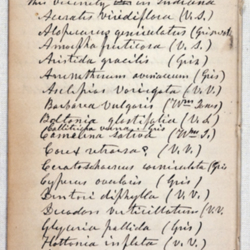Asa Gray, Manual of the Botany of the Northern United States, 1848.
Asa Gray, M. D., Manual of the Botany of the Northern United States, from New England to Wisconsin and South to Ohio and Pennsylvania Inclusive .... Boston, MA: James Munroe, 1848.
Gray’s Manual became an important reference work for Darwin. In 1855, Darwin, greedy for new facts, sent Gray a list of mountain flora he had copied from the book, hoping that Gray would tell him, “from memory,” if any of those occurred elsewhere in the United States than in the locations given or, for that matter, in the world. Gray’s answer followed suit (“I do not believe there is a plant there that is not in Labrador...”), and a correspondence unfolded that became crucial to the acceptance and reception of Darwin’s theory in the United States. Though no botanist, as he readily admitted, Darwin had extended his search for common ancestors to the rest of the world. “I should like to write an essay on species, some day,” Gray announced blithely, apparently unaware of Darwin’s own plans in that direction, “but before I should have time to do it, in my plodding way, I hope you, or Hooker, will do it, and much better far” (June 30, 1855).
A manual of the botany of the northern United States, from New England to Wisconsin and south to Ohio and Pennsylvania inclusive, (the mosses and liverworts by Wm. S. Sullivant,) arranged according to the natural system.
A manual of the botany of the northern United States, from New England to Wisconsin and south to Ohio and Pennsylvania inclusive, (the mosses and liverworts by Wm. S. Sullivant,) arranged according to the natural system.
A manual of the botany of the northern United States, from New England to Wisconsin and south to Ohio and Pennsylvania inclusive, (the mosses and liverworts by Wm. S. Sullivant,) arranged according to the natural system.
A manual of the botany of the northern United States, from New England to Wisconsin and south to Ohio and Pennsylvania inclusive, (the mosses and liverworts by Wm. S. Sullivant,) arranged according to the natural system.
A manual of the botany of the northern United States, from New England to Wisconsin and south to Ohio and Pennsylvania inclusive, (the mosses and liverworts by Wm. S. Sullivant,) arranged according to the natural system.
Dr. Asahel Clapp, “List of plants growing in Kentucky and within 20 miles of New Albany,” autograph.
Gray, a staunch abolitionist, did not include Indiana among the “northern states,” perhaps because of its support for the slaveholders of Kentucky—a fact that clearly irked the owner of this otherwise well-loved association copy, Dr. Asahel Clapp, a physician and Indiana’s first resident botanist, who died in New Albany, Indiana, in 1862. The “x” mark, according to a note left by Dr. Clapp on the front endpaper, “denotes that it belongs to my catalogue of Indigenous and Naturalized Plants found on the north side of the Ohio river and within twenty miles of North Albany, Ind.” For a page from Dr. Clapp’s handwritten catalogue inserted into the Manual, see illustration no. 16.






